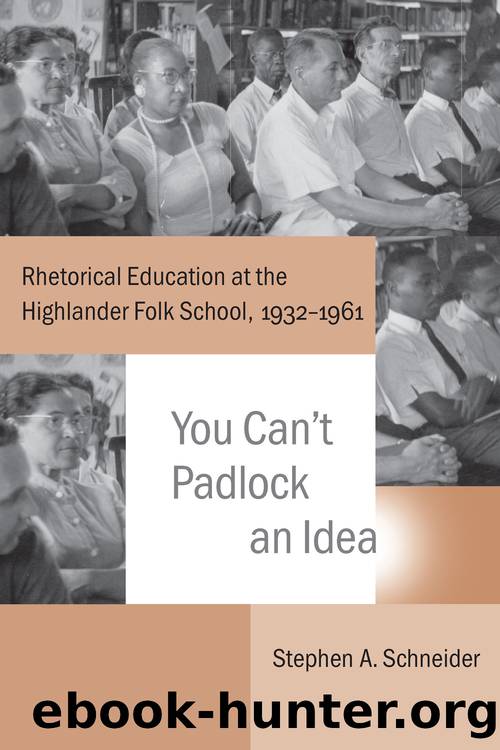You Can't Padlock an Idea by Schneider Stephen A.;

Author:Schneider, Stephen A.;
Language: eng
Format: epub
Publisher: University of South Carolina Press
Published: 2014-08-15T00:00:00+00:00
Autobiographical Writing and Residential Session Yearbooks
The CIO terms held from 1946 to 1953 saw focus shift away from shop papers. In 1946, Highlander Highlights was published just once at the conclusion of the session (Highlander 1946b). There were three papers published during the 1947 term: two issues of The Highlander Flash and one of The Roundup (Highlander 1947b; 1947c). The CIO United was published once during the 1948 session, though it had an unusual length at seven pages (Highlander 1948). The next shop paper on file is the five-issue News from the 1952 term, a one-page production that paid little attention to the journalistic conventions stressed in previous sessions (Highlander 1952). The Bulletin, published for the 1953 term, contained more of the sections and features common to Highlander papers, but little by way of formatting or layout (Highlander 1953).
There seem to be two reasons for this shift in production and quality. The first is the trend toward wall newspapers, which gave students practice in mimeographing and writing without distracting them with larger problems of layout and editorial staff composition. The second is the dramatic shortening of the CIOâs residential sessions, which were reduced from a month in 1944 to a week in 1953. Under these time constraints, it seems that yearbooks became a preferred method of encouraging and collecting student writing. This shift was to prove permanent: with Highlanderâs operational focus moving from the southern labor movement to the civil rights movement, shop papers all but disappeared from the schoolâs curriculum.
It isnât surprising that yearbooks were produced exclusively at residential sessions. These sessions were far more formally organized that extension programs, with definite durations and class schedules. Yearbooks would thus provide an excellent âbookendâ for a successful residential session, and a record of the session for students involved. Highlander staff certainly understood the yearbooks in this way, as they often had students include class summaries and schedules from residential sessions in the yearbooks they produced. By including summaries of residential sessions alongside accounts of the students who attended them, Highlander staff also produced useful publicity materials for future residential sessions. In some cases, yearbooks were made available through Highlanderâs publication order forms (Highlander 1939e, 1).
There were twelve publications that could be classified as yearbooks produced in Highlander residential sessions between 1938 and 1947. The first yearbooks produced at the school were the Highlander Folk School Review and Let Southern Labor Speak, which were produced during the 1938 winter term. The Highlander Folk School Review was a summary of the classes students attended, and a general record of the overall session (Highlander 1938b). Let Southern Labor Speak, which ran to seventy-nine pages, collected âthe speeches made by outstanding labor leaders at the Winter Term, 1938, of the Highlander Folk School, Monteagle, Tennessee, also the dramatic stories of labor experiences as told by the students gathered from southern statesâ (Highlander 1938c, 1). The speeches were collected in the first section of the book, but the bulk of the text was devoted to student stories about their own labor struggles.
Download
This site does not store any files on its server. We only index and link to content provided by other sites. Please contact the content providers to delete copyright contents if any and email us, we'll remove relevant links or contents immediately.
We Ride Upon Sticks by Quan Barry(33985)
The Secret History by Donna Tartt(18104)
Norse Mythology by Gaiman Neil(12796)
Crooked Kingdom: Book 2 (Six of Crows) by Bardugo Leigh(11949)
The Betrayed by Igor Ljubuncic(11618)
The Betrayed by Matthew Dickerson(11420)
Caraval Series, Book 1 by Stephanie Garber(9885)
Year One by Nora Roberts(9279)
Oathbringer by Brandon Sanderson(9170)
Twilight Siege: A Dark Fantasy Novel (The Fae Games Book 2) by Jill Ramsower(8933)
The Priory of the Orange Tree by Samantha Shannon(8553)
The City of Brass by S. A. Chakraborty(8492)
Red Rising by Pierce Brown(8229)
Confessions of an Ugly Stepsister by Gregory Maguire(7657)
Little Fires Everywhere by Celeste Ng(6838)
Shalador's Lady by Anne Bishop(6618)
Storm and Silence by Robert Thier(6470)
This Is How You Lose Her by Junot Diaz(6417)
Shadows Of The Apt [01] - Empire in Black and Gold by Adrian Tchaikovsky(6399)
